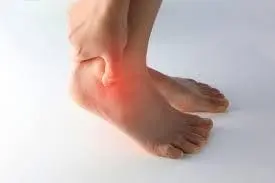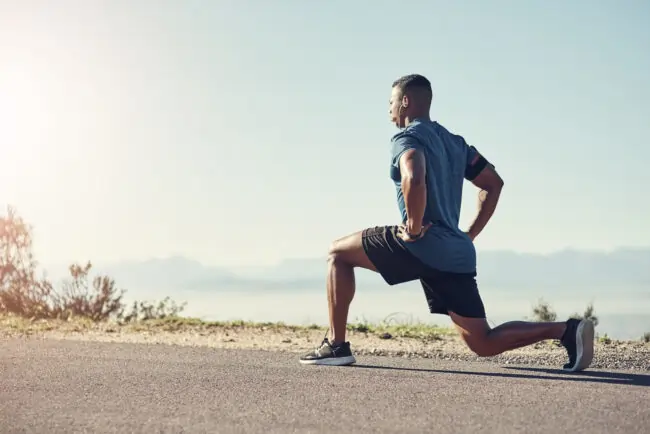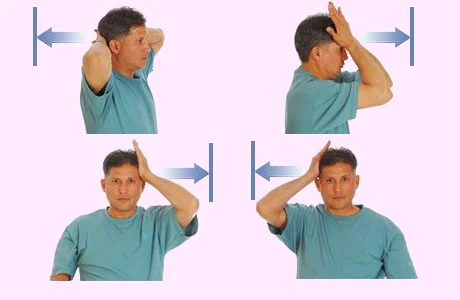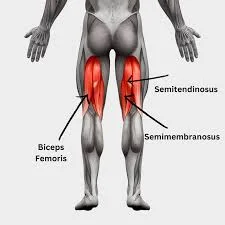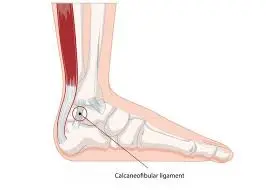Ankle Pain While Walking: Cause, Symptoms, Treatment
Ankle pain while walking can be a frustrating and limiting experience, affecting daily activities and overall mobility.
There are far too many factors that might cause Ankle Pain when walking. so, a correct diagnosis is necessary before treatment options can be chosen. To be sure the diagnosis is reliable, the doctor will examine you physically and review your medical history. Making the right diagnosis could help with treatment selections.
This article explains the causes of ankle pain while walking and methods for diagnosing and treating the condition.
What is ankle pain while walking:
- Ankle joints are among the most important and hard-working body parts.
- Ankle problems are frequently caused by injuries or illnesses, which can make walking painful. Ankle pain is defined as pain that affects any region of the ankle joint.
- Usually, relaxation, ice, and over-the-counter painkillers are used as home treatments for ankle pain. A patient can benefit from a physical therapy program by building muscle and avoiding further damage. More severe pain is treated by doctors with splits, braces, injections, and surgery.
- The patient may have stiffness or soreness anywhere near the ankle, depending on what’s causing it. The patient may also have swelling and stiffness in their ankle. Surgery is not usually required for moderate medical conditions. However, surgery is required when nonsurgical treatment fails or the injury is serious, such as a broken ankle bone.
- A physical therapy (PT) treatment plan can also help in the patient’s recovery if they have surgery or an ankle injury. Ankle and foot support muscles are strengthened by a physical therapist. Both pain relief and injury prevention are possible with physical therapy.
What could be causing general walking-related ankle pain?
- Osteoarthritis
When the joints’ cartilage decreases, it develops osteoarthritis. This could be the reason for the patient’s ankle pain, particularly if they are older, overweight, or perhaps have a history of ankle injuries.
- Gout
An example of an arthritis is gout. This condition develops when the blood does not absorb uric acid as it should. instead, it breaks down and develops in the joints, which can be painful. The big toe may be the first joint to hurt, then the lower leg, heel, and other joints.
- Bruising
Walking may be painful for the patient if they have injured their ankle, perhaps from a hit or kick. In general, this kind of trauma’s pain will go away in two to three weeks.
- Sprain or strain
An injury to the soft tissues in the ankle can result in both strains and sprains. One possible explanation for this injury is a strained ligament or tendon.
Additionally, bacteria may cause septic arthritis by entering the ankle joint through trauma or an animal bite. Most often, this type of arthritis affects younger people and elderly people. Septic arthritis is another risk for those with prosthetic joints.
- Plantar fasciitis
The fascia may be strained and stressed, leading to little tears in the joint. Although the cause of plantar fasciitis is still unknown in many cases, the fascia can become irritated or inflamed due to continuous straining and tearing.
- Achilles tendon rupture
Usually takes place when a patient engages in strenuous physical activity or sports. It appears as an Achilles tendon tear. Chances are it is the result of an accident, particularly from jogging on uneven surfaces or tripping over a hole.
- Sinus tarsi syndrome
Ankle pain, burning, tingling, or even weakness can be caused by injury to the ligaments, blood vessels, or even the nerves inside or surrounding the tunnel. This condition is called sinus tarsi syndrome. Maintaining the foot in the best possible position to allow the injured components to recover may be part of the treatment for sinus tarsi syndrome.
- Fractures
Walking with a broken or fractured bone will probably cause severe pain for the patient. Typically, fractures can be followed by edema, redness, or even numbness in the toes. Ankle fractures typically take weeks to fully heal and require medical treatment.
- Bunions
The primary foot abnormality is essentially known as a bunion. Bunions cause people to have outward-pointing toe and inner-foot lumps. When the bunions deepen and ulcers develop, the patient might need to modify their weight to avoid difficulty when walking.
Signs and symptoms:
- Ankle edema
- Bruising
- Redness
- Numbness or tingling
- Ankle Pain
How is ankle pain diagnosed?
The patient’s foot, ankle, and lower leg will all be examined by the doctor during the physical exam. Moving the patient’s foot to check the range of motion and determine which postures cause discomfort or pain in the ankle, the doctor will palpate the skin surrounding the injury to feel for specific painful spots.
The doctor may recommend one or more of the following imaging procedures in cases of severe injury in order to rule out a shattered bone or even to determine the degree of ligament injury more accurately.
- X-ray
A tiny quantity of radiation travels into the patient’s body during an X-ray to create images of the surrounding areas and the entire ankle joint’s bones. This is the most accurate way to detect bone fractures.
- MRI
To provide incredibly detailed longitudinal or three-dimensional images of the soft interior tissue of the ankle joint, including ligaments, magnetic resonance imaging (MRI) primarily uses radio waves and a strong magnetic field.
- CT scan
A CT scan might provide the doctor with more information about the joint’s bones. To create cross-sectional or three-dimensional images, a CT scan combines X-rays taken from various angles.
- Ultrasound
An ultrasound creates images of the ankle by using sound waves. With the foot in various positions, these photos can help the physician identify the state of a ligament or tendon.
Special tests for ankle pain while walking:
- Anterior Drawer test
To check for any damage to the ankle’s anterior talofibular ligament;
The patient is initially in the supine posture with the ankle joint in a 20° flexion after the heel is resting on the table-supported palm of the therapist. The calcaneus bone should then be stabilized by the therapist. The therapist then compresses the calcaneus while the tibia and fibula remain stable. The objective is to assess the degree of anterior translation of the ankle’s lateral side and the sensation of its termination.
It is noted how much forward rotation occurs when the end feel gradually weakens and eventually changes from hard ligamentous to weak elastic. If there is an anterior rotation of more than one centimeter about the normal opposite ankle and a noticeable weakening of the end feel, The most common cause is a partially or totally torn anterior talofibular ligament in the ankle.
- Posterior drawer test
Ankle tests like this one are performed to check for ligamentous instability and injuries to the posterior talofibular ligament.
First, have the patient lie supine with their knee slightly bent to alleviate the pull of the gastrocnemius muscle in their lower limb. Holding the ankle joint at 10 to 15 degrees of plantar flexion, the therapist uses one hand to stabilize the tibia bone from the anterior side while using the other to grab around the heel. While holding the tibia bone with the other hand, the examiner moves the foot posteriorly at the ankle joint after asking the patient to relax their muscles.
When the proximal tibia slips back (excessive translation) and there is no end-feel, the test is considered positive. The degree of posterior displacement defines the grade of the PCL injury.
- Talar Tilt test
The talar tilt test is used to identify any damage to the calcaneofibular and anterior talofibular ligaments.
Initially, the patient rests with their ankles and feet unsupported. Ten to twenty degrees of plantarflexion are in the foot’s position. With one hand, the distal lower limb is stabilized immediately proximal to the malleoli, and the other is used to invert the hindfoot. To check for twisting, the lateral side of the talus is inspected.
- Cotton Test
This test’s objective is to detect joint syndesmotic instability. The talus bone’s lateral displacement within the ankle joint is measured by this manual stress test. The medical professional moves the talus bone laterally while stabilizing the proximal ankle. A sprain of the subtalar joint or the distal tibiofibular syndesmosis is indicated by greater motions in comparison to the healthy side in a positive test.
Treatment:
Medical care
Painkillers such as ibuprofen (Advil, Motrin IB, and others), naproxen sodium (Aleve, and others), or acetaminophen (Tylenol, and others) are utilized in the majority of cases with ankle pain, regardless of how serious the condition is.
Physical therapy treatment:
Electrical modalities:
This therapy approach helps the patient reduce pain in the ankles, ease nerve pain, speed up the recovery of musculoskeletal injuries, improve blood flow, treat wounds, and relax muscle spasms.
- Ultrasound
To lessen pain, the US is primarily applied to tender sites.
The patient benefits mostly from this treatment in terms of pain relief.
- Transcutaneous electrical nerve stimulation
This method is used to reduce edema, redness, and pain.
Exercises:
Towel stretch
- Sitting down on the ground is the initial step.
- Around your heels, place a towel that has been wrapped up from both ends.
- Take your time pulling the cloth toward yourself, maintaining your knee upright.
- Hold this position for a few seconds.
- Then return to your neutral position.
- Then relax.
- Repeat this exercise five to ten times.
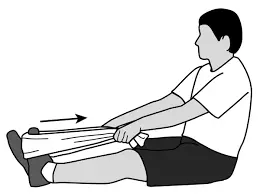
Ankle circle
- To start, choose a spot on the ground where you can sit comfortably.
- Take ten gentle turns with your ankle in both directions, clockwise as well as counterclockwise.
- Make gentle movements with your foot and ankle to prevent your entire leg from twisting.
- To add some variation, try circling the letters with your big toe.
- Then return to your neutral position.
- Then relax.
- Repeat this exercise five to ten times.
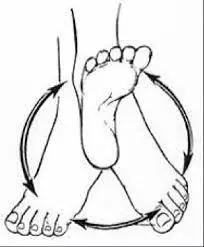
Seated Plantar Fascia Stretch
- Sit with your ankle resting on your other leg and cross your legs over your other knee.
- Carefully move your toes back to stretch the bottom of your foot while holding your ankle with one hand and grabbing your toes with the other.
- Hold this position for a few seconds.
- Then return to your neutral position.
- Then relax.
- Repeat this exercise five to ten times.
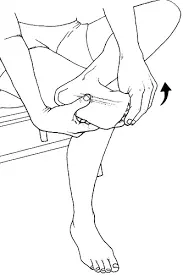
Big toe stretch
- The first thing you should do is sit down in a chair.
- After that, crossover your left leg into your right.
- Using your fingers, gently extend the big toe horizontally, upwards, and downward.
- Use the big toe to hold this posture for a few seconds.
- Then return to your neutral position.
- Then relax.
- Repeat this exercise five to ten times.

Standing calf stretch
- Get three to four feet away from the wall.
- Step forward with the foot that isn’t being stretched, and the calf that is being stretched will be behind you.
- Lean against the wall without bending your back or back knee, having your toes pointed forward with your heel on the floor.
- Hold this position for a few seconds.
- Then return to your neutral position.
- Then relax.
- Repeat this exercise five to ten times.
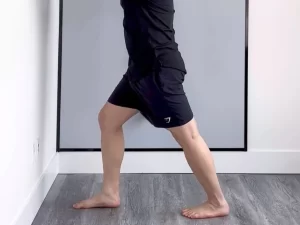
Toe raise, point, and curl
- To begin, stand upright on the ground.
- Elevate your heels while keeping your toes firmly planted on the floor.
- Stop, since just your feet remain on the ground.
- Hold this pose for a few seconds then let go of your heels and take a step down.
- At the next step, you should only contact the tips of your big and second toes, with your heels up and your toes pointing down.
- Let go after a short while.
- Raising your heels and curling them in will get you to the third level, where your toe tips are the only thing touching the floor.
- Hold this position for a few seconds.
- Then return to your neutral position.
- Then relax.
- Repeat this exercise five to ten times.
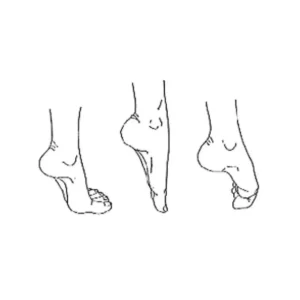
Toe splay
- Begin by standing on the floor.
- Extend your toes as wide apart as you can without getting tired.
- Hold this position for a few seconds.
- Then return to your neutral position.
- Then relax.
- Repeat this exercise five to ten times.
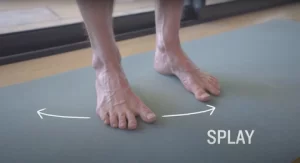
Towel curl
- Sit down on a chair and place your heels on the ground.
- Your toes should be directed forward, and your legs and feet should be straight to one another.
- Towel corners should provide stability for your heel.
- Get your foot as far down on the towel as you can by stretching your middle foot and both toes.
- Grab the towel with your toes and move it with you.
- A tiny piece of towel will be provided for you to move with each time you pull back and straighten your foot.
- Then return to your neutral position.
- Then relax.
- Repeat this exercise five to ten times.
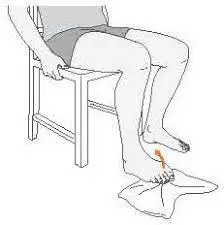
Golf ball roll
- Position yourself on the chair to begin.
- Ideally, you want to put a golf ball down near your feet.
- By using one foot to exert as much pressure as feels relaxing, the ball can be rotated in different directions.
- The object pressing against the foot is supposed to be the ball.
- Keep moving the ball for a few more minutes.
- Then return to your neutral position.
- Then relax.
- Repeat this exercise five to ten times.
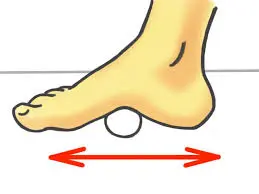
Heel Raises
- Choose a location where you can stand without difficulty.
- If you need support, grab a chair.
- Raise your heels now.
- Hold this position for a few seconds.
- Drop your heels.
- Then return to your neutral position.
- Then relax.
- Repeat this exercise five to ten times.
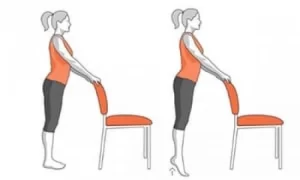
Ankle Plantarflexion
- First, take a seat on the floor.
- Make a knee bend in one leg.
- Grab the ends of the resistance band with both hands, then drag it across the front of your foot.
- Your toes should be gradually pointed forward and backward to release pressure.
- Hold this position for a few seconds.
- Then return to your neutral position.
- Then relax.
- Repeat this exercise five to ten times.
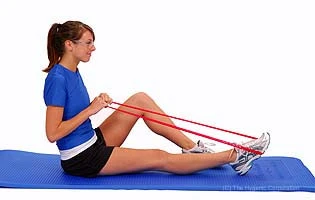
Ankle dorsiflexion
- Sit down on the ground.
- Put the band around one foot after fastening it around the leg of a chair or table.
- Upon lightly pointing your toes toward yourself.
- Hold this position for a few seconds.
- Then return to your neutral position.
- Then relax.
- Repeat this exercise five to ten times.
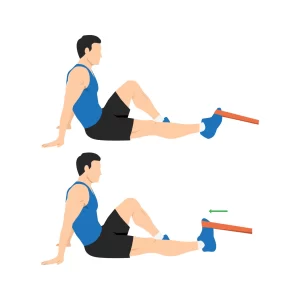
Marble pickup
- Both feet should be straight on the ground while you sit up straight on a chair.
- Place two bowels there. One contains ten to twenty marbles, and one is empty.
- Using only the toes of one foot, put every marble into the unfilled basin.
- Then return to your neutral position.
- Then relax.
- Repeat this exercise five to ten times.
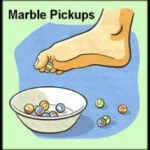
Alphabet write with the toe exercise
- Select a comfortable sitting or standing position.
- Raise your foot a few inches and use your big toe to write the alphabet, beginning with the capitals.
- Work down with lengthy movements.
- Lowercase letters should be written after you have completed the alphabet.
- Then return to your neutral position.
- Then relax.
- Repeat this exercise five to ten times.

Ice bottle massage exercise
- You have to place one foot on a cold water bottle while seated in a chair.
- Because it reduces inflammation, a bottle of ice-filled cooled water is good.
- To get the water bottle or ball beneath your foot, move it back and forth.
- Start just beneath your foot’s middle and finish right in front of your heel.
- Rotate the bottle or ball back and forth carefully after all ten repetitions.
- Then return to your neutral position.
- Then relax.
- Repeat this exercise five to ten times.

Sand walking
- Look out for any sandy area you come across, such as a beach, a volleyball court, or a desert.
- Off with your shoes and socks.
- Enjoy as many walks as you can.
- To prevent overstretching your feet and calves, try to increase the distance gradually.
- Then relax.
- Repeat this exercise five to ten times.

What security precautions should be taken when exercising?
- Wear loose, comfortable attire during the exercise session to increase your range of motion and promote relaxation. Stay away from anything overly fashionable or tight clothes.
- According to the protocol, stretching should be performed both before and after sets, as well as during the specified number of repetitions for every exercise.
- Bending and stretching should be done gradually.
- When exercising, try not to use any force or quick motions.
- Refrain from taking on challenging tasks.
- Between workouts, take a break.
- When exercising, be focused and watch for yourself to prevent slipping.
- Straighten your posture when working out.
What time will you stop exercising?
- Fever
- If exercising hurts, you should stop.
- Intense muscle burning.
- You’re not feeling well.
- If there is pain or numbness.
- A vision that is blurring
- Headache
How to Avoid Ankle Pain During Walking:
- Be careful when approaching tough surfaces
It could be advantageous for walkers or runners to stray from their regular paths, but proceed with caution if you run or walk on climbs with uneven or unstable surfaces. Although there is not anything to be afraid of or avoid in these areas, use care when you are walking there and be aware of any distractions (e.g., While trekking, or reading ). Starting to walk on a level surface might be beneficial if your ankle pain is severe. As your ankle strength improves, advance to stairs or rough surfaces.
- Relaxation and healing
Regardless of your active lifestyle or if you are trying to heal from an accident that is causing your ankle pain, it is important to rest your ankle. While your ankle heals, limit the amount of movement that puts tension on it. Resting the ankles after exercise is recommended for people who frequently stress them. The strained muscles and joints are going to have time to calm and heal.
- Physical therapy
In addition to helping you reduce of your present ankle pain, a physical therapist may also help you improve the general condition of the affected area and increase your walking function and mobility. Joint mobilization, therapeutic exercises, and recommendations for suitable footwear are some of the therapy options that can help reduce ankle pain and improve overall mobility. Before and after exercise, your therapist can also guide you through daily activities to maintain strong and flexible ankles.
- Replace your worn-out footwear.
Stability and strength can be maintained and ankle strain can be lessened by replacing old, worn-out shoes. It is generally recommended that you replace your shoes every 350 to 450 kilometers (or every 6 months if you are very active).
Summary:
Your ankle is a complicated structure made up of cartilage, tendons, ligaments, and bones. When you stand, run, or move about, it helps you keep your balance as you move. Ankle pains are frequently caused by ailments or injuries, which can make walking painful. Common injuries such as sprains and medical diseases including gout, arthritis, and nerve damage are typical causes of ankle pain. Swelling and bruises are a frequent form of pain that often lasts one to two weeks.
Try to rest, elevate your foot, and ice your ankle three to five times a day for the first several days throughout that period. Over-the-counter (OTC) medicines could also offer some relief.
If, on the other hand, the pain continues to exist see a doctor to discuss your treatment choices. They include physical therapy, surgery, footwear, and special ankle braces.
FAQ:
What causes the lower portion of my ankle to pain as I walk?
Bottom of the ankle pain might result from inflaming this bursa, which is caused by overuse of the ankle joint by frequent walking, jogging, or running. Bursitis-related ankle pain may feel uncomfortable to the touch and worsen with movement. An obvious “pump swelling” may develop on the outside of the ankle when this bursa becomes inflamed.
Does ankle pain resolve on its own?
Most cases of foot and ankle pain are acute and are caused by soft tissue injuries such as sprains or strains. With a few easy self-care techniques, these should progressively heal. You won’t likely require medical attention from a specialist, though some people may need many months for complete recovery.
Is ankle pain something I should neglect?
Your pain and inflammation will last significantly longer without therapy if you continue to use your ankle and don’t give it the time and attention it needs. This suggests that you may experience months of difficulty performing daily activities like walking, driving (if it’s your right ankle), and working.
Why does a sudden walk pain my ankle?
Numerous disorders, such as autoimmune diseases, various forms of arthritis, and problems with foot alignment, can produce sudden discomfort in the ankle without any physical trauma. Ignored diseases like gout and arthritis can have devastating effects.
Is there a way to alleviate ankle pain?
If you follow some easy self-care guidelines, a soft tissue injury should heal within several days. However, you might need to take precautions and keep the injured region covered for a few months until it fully heals.
References:
- On October 9, 2018, Sawyers, T. Ankle Pain When Walking. The website Healthline provides information on ankle pain that may occur during walking.
- D. Shah (2023, Dec. 30). The causes, remedies, and prevention of ankle pain during walking. Mobile Clinic for Physiotherapy. Walking with pain in the ankles? Visit https://mobilephysiotherapyclinic.in
- Flex Your Soles. (n.d.). [Video]. The website Hingehealth provides information on ankle pain during walking.
- Expert, C. C. M. (n.d.). Ankle Pain: Cleveland Clinic. Available at https://my.clevelandclinic.org/health/symptoms/15295-ankle-pain
- On April 30, 2022a, Prajapati, N. The causes, symptoms, treatments, and exercises of ankle pain during walking. Treatment for ankle pain during walking is available at Samarpan Physiotherapy Clinic.

